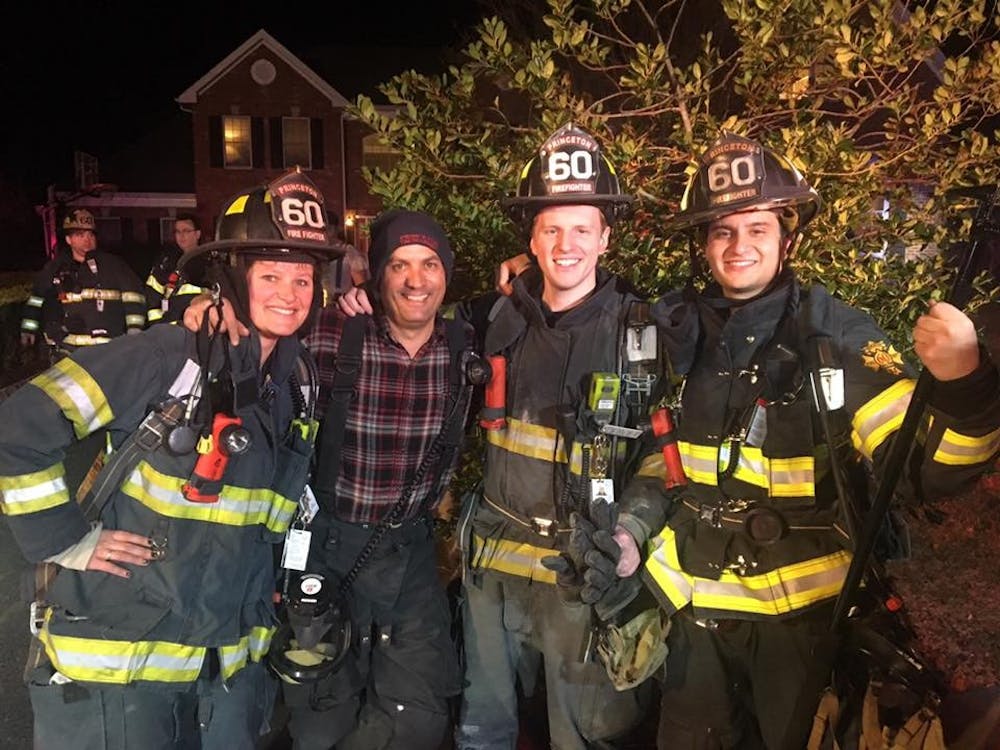Of the roughly 1,000 calls the Princeton Fire Department receives every year, 100 percent are answered by volunteers. When a call comes in, these volunteer firefighters rush to the Witherspoon Street firehouse, don their turnout gear, and board a fire engine. The process takes under 10 minutes.
Five of those volunteers are University students.
The partnership between the University and the town fire department has existed informally for decades, but was formalized in 2006 with the creation of the Princeton Student Firefighter Association, said Bob Gregory, Princeton Fire Department’s Director of Emergency Services. The three to six students that are involved every year are full-fledged members and go through intensive training.
That means 170 hours of learning about fire suppression, forcible entry, and “all the fun stuff,” says Amanda Hurley, a sixth-year graduate student in molecular biology at the University.
Hurley signed up to become a volunteer firefighter five years ago at an activities fair. She was thrilled she had the chance to do so; she even wrote about firefighters for a writing class.
“I never had the opportunity [to be a firefighter] before I came to Princeton, because they have such a well-established program for getting students into the fire department,” Hurley said.
Gregory hailed the importance of the program and the students it brings in. The students “give the fire department another set of eyes on things. A lot of the students are very good because they’re analytical,” he explained.
“We’ve had a couple of students help in ... SOPs, standard operating procedures,” Gregory said. “We’ve had some students look at how we do things and say, ‘Hey, I think we’d be better off doing it this way or that way.’”

Hurley and other student volunteers said their service has been a benefit to them, as well as the community.
Danielle Sawtelle ’17, one of the volunteers, said that she enjoys the chance to get out of the Orange Bubble and work with the other volunteers, most of whom are either older adults or younger high schoolers.
“As a student, it’s cool ... to interact with people who are in different stages of life,” Sawtelle said. “They always check in on how classes are doing and it kind of brings some of the University to them, as well.”
Classes occupy time and school is important, but academic demands don’t deter the hardworking University volunteers, who take at least 15 percent of the calls the department receives, including three active-duty nights per month on which they must respond to whatever calls come in.

When asked how she balances being a volunteer firefighter with being a graduate student in molecular biology, Hurley laughed and said, “I just never told my boss. I figured if my work was slipping, she would tell me, but she never brought it up.”
“Sometimes when you’re in the lab or you’re doing a lot of intellectual stimulation, it feels really good to just get out there and do physical, productive work that has a beginning and end, you know?” Hurley explained. “Grad school sometimes feels like it’s never going to end, but if you go put out a fire, you’re like, ‘I did something today. And it feels amazing.’”
“Being a firefighter is one of the most rewarding things I’ve ever done,” Hurley added.
That passion is vital to keeping the Princeton Fire Department thriving. The response force consists of about 30 volunteers, meaning that these student firefighters make up nearly 20 percent of the department’s numbers.
Gregory has been in the firefighting business for 30 years, and has been stationed in Princeton for 18 of those. Fire Chief Dan Tomalin has been at the department for 30 years, Deputy Chief Kyle Rendall for 25, and Assistant Chief Salvatore Baldino for 15.
“The volunteer fire department used to have more of a fixed community base, where people would stay in,” explained Gregory, adding, “The majority would be like Dan and Kyle and Sal.”
But now, their long records of service are the exception.
Because people seem to move around more, Gregory says, “it has gotten a lot more difficult to maintain volunteer levels. But the program with the University helps us tremendously.”








